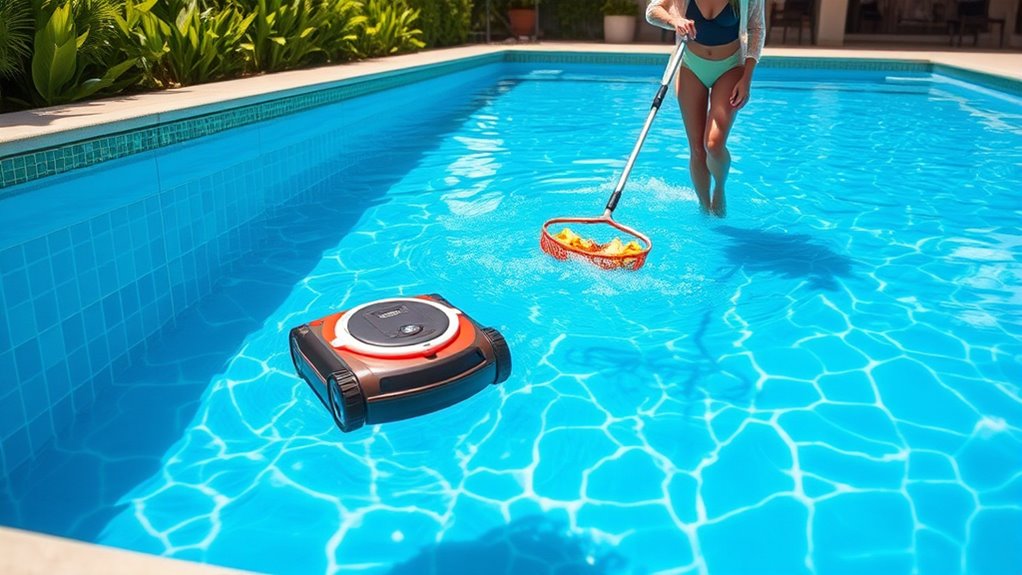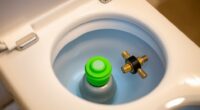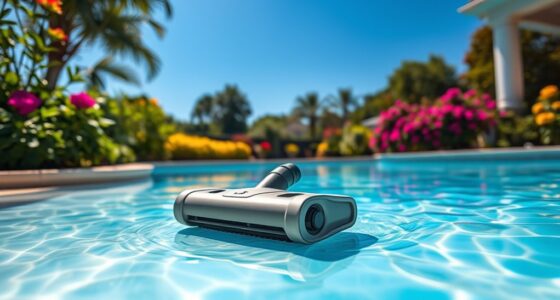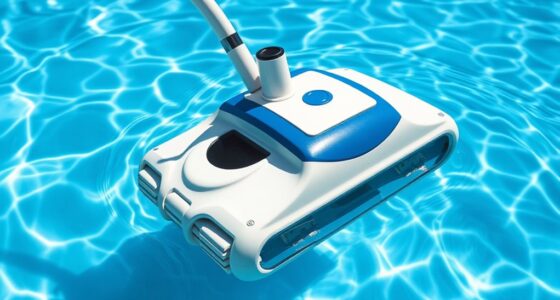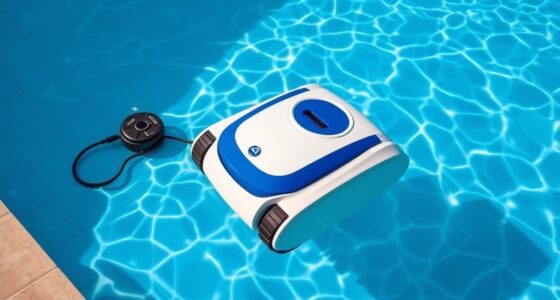To maintain a sparkling, bacteria-free pool, regularly balance chemicals and inspect equipment while using automatic devices like robotic vacuums and skimmers to handle daily debris. Combine these with manual tasks such as skimming, brushing, and vacuuming weekly or after storms to target stubborn dirt and algae. Keep an eye on filter pressure and perform routine maintenance for peak performance. Keep these tips in mind to achieve clear water—more detailed strategies follow.
Key Takeaways
- Implement a weekly routine combining automatic devices with manual surface skimming for comprehensive debris removal.
- Schedule regular chemical testing and adjustments to maintain water balance alongside filter and equipment inspections.
- Use robotic vacuums and automatic skimmers daily, supplemented by manual brushing and vacuuming as needed.
- Monitor filter pressure routinely to detect issues early, ensuring optimal automatic filtration performance.
- Balance automated cleaning with manual practices to prevent algae, calcium buildup, and equipment wear, prolonging pool health.

Are you wondering how to keep your pool sparkling and inviting all season long? The key lies in establishing a consistent cleaning schedule that combines automatic and manual methods. To do this effectively, you need to focus on maintaining the proper chemical balance and ensuring your equipment stays in top shape. When your pool’s chemical levels are balanced, algae and bacteria are kept at bay, and your water remains clear and safe for swimming. Regular testing of pH, chlorine, alkalinity, and calcium hardness should become part of your weekly routine. Adjust the chemicals as needed to keep these levels within the ideal range. This not only improves water quality but also reduces strain on your filtering system and other equipment. Proper equipment maintenance is equally essential. Rinse and inspect your pump, filter, and skimmer baskets regularly. Clean or replace filters as recommended by the manufacturer, and make sure your pump is functioning efficiently. Neglecting this can lead to clogs, reduced circulation, and increased energy costs, all of which compromise your pool’s cleanliness. Additionally, understanding your filter system performance can help optimize water flow and cleaning efficiency. Regularly observing filter pressure can alert you to potential issues before they become costly problems. Incorporating modern filtration systems can further enhance water clarity and reduce chemical usage, making your maintenance routine more efficient. Automatic cleaning devices, like robotic vacuums and pool skimmers, are excellent for daily or weekly upkeep. Set your robotic cleaner to operate during off-peak hours to save energy and keep debris from settling. These devices can handle dirt, leaves, and bugs, reducing the manual effort needed and ensuring your pool remains debris-free between deep cleanings. However, relying solely on automation isn’t enough. Manual cleaning should still be part of your schedule. Skim the surface daily to remove floating debris, and brush the walls and floor weekly to prevent algae buildup and calcium deposits. Vacuum the pool manually when you notice stubborn dirt or after storms. This hands-on approach helps prevent algae blooms and keeps your pool looking pristine. Incorporating advanced filtration methods can further enhance water clarity and reduce chemical usage, making your maintenance routine more efficient. A well-maintained filtration system is essential for keeping your water crystal clear, especially when combined with effective routine cleaning. Balancing automatic and manual cleaning creates an efficient, effective pool maintenance routine. Automatic tools handle regular debris and help maintain circulation, while manual cleaning targets areas that equipment might miss. Remember, consistent attention to chemical balance and equipment maintenance simplifies the task and prolongs the lifespan of your pool’s components. By sticking to this schedule, you’ll enjoy crystal-clear water and a healthy swimming environment all season long, with less stress and fewer surprises.
Frequently Asked Questions
How Often Should I Replace My Pool’S Automatic Cleaner Filters?
You should replace your pool’s automatic cleaner filters when you notice a decline in performance, such as reduced suction or debris removal. Regular filter replacement is key to cleaner maintenance and keeping your pool sparkling. Typically, filters need changing every 3 to 6 months, but this depends on usage and water conditions. Keep an eye on the filters, and replace them promptly to ensure your automatic cleaner runs efficiently.
Can Manual Cleaning Damage My Pool’S Liner or Surface?
Imagine manual cleaning as a gentle gardener tending delicate flowers; if you scrub too hard, you risk damaging the petals, just like your pool’s liner or surface. With proper pool liner maintenance and balanced chemicals, manual cleaning becomes safe and effective. Always use soft brushes and gentle strokes to avoid scratches or tears, ensuring your pool stays pristine without harm. Proper care preserves your pool’s beauty and longevity.
What Are Signs That My Automatic Cleaner Is Malfunctioning?
If your automatic cleaner isn’t working properly, look for signs like robotic malfunctions or suction failure. You might notice the cleaner isn’t moving as it should, leaves or debris remain on the pool floor, or it makes unusual noises. These issues often point to motor problems, clogged filters, or disconnected hoses. Regularly inspect your cleaner to catch these signs early and keep your pool spotless.
Is It Necessary to Manually Scrub Algae Even With an Automatic Cleaner?
Even with an automatic cleaner, manual scrubbing is often necessary for effective algae control. Automatic cleaners can’t reach every nook or remove stubborn algae buildup, so you should manually scrub those areas. Regular manual scrubbing helps prevent algae from spreading and keeps your pool crystal clear. Balancing automatic and manual cleaning guarantees your pool stays well-maintained and algae-free, saving you time and effort in the long run.
How Do Weather Changes Affect My Pool Cleaning Schedule?
Weather impact and seasonal maintenance considerably influence your pool cleaning schedule. As temperatures change or storms occur, you’ll need to adjust your routine—more frequent skimming after storms or increased chemical checks during hot, sunny days. Seasonal maintenance might include winterizing or opening your pool, which requires extra effort. Staying attentive to weather changes helps you maintain a clean, healthy pool, ensuring you enjoy it year-round without unexpected issues.
Conclusion
By balancing automatic and manual cleaning, you can keep your pool pristine with less effort. Did you know that regular maintenance can extend your pool’s lifespan by up to 20%? Staying on top of your cleaning schedule not only saves you time and money but also guarantees a healthier swimming environment. So, stick to your plan, and enjoy crystal-clear water all season long—your pool will thank you!
